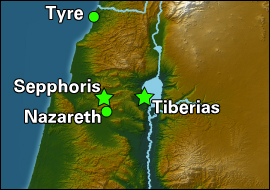%%Q. How does domestic architecture vary in the Second Temple period? Is the four-pillared Iron Age house still mainly in use, or has the floor plan gone all Hellenistic?
A. Four-roomed houses are so called because the ground floor is divided into four rooms, the largest of which served as a courtyard and/or work area. Grinders and loom weights are among the artifacts frequently found in these rooms. The other rooms in the house were used as bedrooms and/or storage. Since most four-roomed houses had an upper story, they were well suited for habitation by extended family groups—up to three generations of a family. Four-roomed houses are frequent in hill country settlements during the Iron I, and in Israelite towns and cities during the Iron II and III. They were, in other words, the most common type of house in ancient Israel.
By the time of Jesus the layout of the four-roomed house had largely disappeared, but vestigial remnants persist, particularly the courtyard/work area. At Gamla, Yodfat, Capernaum, Khirbet Qana, and Sepphoris, excavated houses from the Early Roman period consist of a cluster of rooms around a courtyard and/or work area. Most of the rooms around the courtyard were used as bedrooms and/or storage. The arrangement of rooms is organic—new rooms were added when needed, as space permitted. Like their four-roomed predecessors, these Early Roman houses were well suited for habitation by extended family groups. Several houses at Sepphoris also include a mikveh, or ritual bath.
In Jerusalem, the floor plans of Early Roman houses also typically feature a cluster of rooms around a courtyard or work area. The other rooms appear to have been bedrooms or storage, and it is not unusual to find a room devoted to a mikveh or ritual bath.
Markers of Hellenization and Romanization appear in some of these houses, in the form of mosaic floors, frescoed walls, and ornamented stucco cornices. The priestly houses in Jerusalem have these features, as do one house at Sepphoris, one at Gamla, and one at Yodfat. The layout and ornamentation of these houses provides archaeological evidence for both accommodation and resistance to the pressures of Hellenization and Romanization.
But the typical layout of houses in the Roman world, the so-called “axial peristyle” house, is not common in Early Roman Galilee or Judea. Most of the houses at Pompeii, for example, are built on this typical Roman floor plan. In later periods it becomes more common in Israel: the famous “Mona Lisa of the Galilee” mosaic at Sepphoris was found in the triclinium (dining room) of a third-century axial peristyle house.



